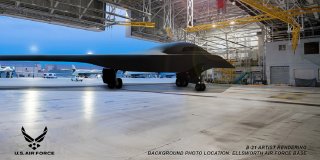New B-21 Stealth Bomber Can Evade Russian-Made Air Defenses
Should the B-21 be what it is purported to be, it may indeed be engineered with new, much more advanced, paradigm-changing stealth properties.
Here's What You Need To Remember: Unlike fighter jets, many of which have vertical structures more detectable to enemy radar return signals, smooth horizontal bombers such as the B-2 or new B-21 are designed to elude both surveillance and engagement radar, and therefore conduct operations without an enemy even knowing something is there.
The very first Air Force B-21 Raider stealth aircraft is nearing completion in preparation for its expected first flight sometime in the coming year, marking a seismic shift in U.S. ability to project power globally and, if needed, hold otherwise unreachable adversaries at risk of close-in air attack.
The first one has not as of yet “reached final assembly,” according to a report in Air Force Magazine, however the publication quotes the director of the Air Force Rapid Capabilities Office Randall Walden saying the plane is “really starting to look like a bomber.”
Several years ago, an Air Force three-star weapons developer told The National Interest that the new B-21 will operate with an ability to hold “any target at risk, anywhere in the world, at any time.”
What this may mean is that senior Air Force weapons developers are finding a way to refer to how the B-21s new never-before-seen stealth characteristics may in fact enable the aircraft to operate undetected against the most advanced, Russian-made air defenses in the world.
Should this be true, and it may very well be, it would represent a massive breakthrough development. Russian-built S-400s and S-500s are known to introduce new levels of detection capability, believed and claimed by some to even operate with an ability to detect stealth aircraft to a degree. They now function with much faster computer processing speeds, digital real-time point to point networking between air defense nodes and an ability to operate on a wider sphere of frequencies.
While this by no means indicates that a platform such as a B-2 could get found and shot, it would not be a bad estimation to think that the threats presented by these new air defenses have, at least to some extent, inspired current upgrades to the B-2. In fact, B-2 bombers are now being engineered with a special new technology called the Defensive Management System, an advanced sensor designed to find the locations of enemy air defenses, inform bomber crews and therefore enable B-2 pilots to navigate away from or “around” these air defense systems. For example, even if a B-2 succeeds in eluding high-frequency, fast-moving engagement radar and therefore cannot actually be shot down in flight, it might be seen by lower-frequency, wide spanning surveillance radar. Surveillance radar cannot shoot down an enemy, but it is dangerous in that it is intended to simply identify that an attacking threat is at least “there” in the airspace.
Unlike fighter jets, many of which have vertical structures more detectable to enemy radar return signals, smooth horizontal bombers such as the B-2 or new B-21 are designed to elude both surveillance and engagement radar, and therefore conduct operations without an enemy even knowing something is there. Effective stealth technology, which includes a mix of composite, radar absorbent materials, heat signature management and smooth blended aircraft shapes devoid of sharp edges or contours more likely to generate a rendering of some kind to electromagnetic radar pings.
Should be B-21 be what it is purported to be, it may indeed be engineered with new, much more advanced, paradigm-changing stealth properties.
Kris Osborn is the defense editor for the National Interest. Osborn previously served at the Pentagon as a Highly Qualified Expert with the Office of the Assistant Secretary of the Army—Acquisition, Logistics & Technology. Osborn has also worked as an anchor and on-air military specialist at national TV networks. He has appeared as a guest military expert on Fox News, MSNBC, The Military Channel, and The History Channel. He also has a Masters Degree in Comparative Literature from Columbia University.
This piece first appeared earlier this year and is being republished due to reader interest.
Image: U.S. Air Force..

